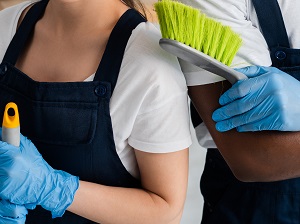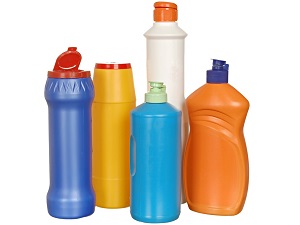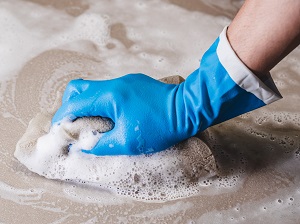Any worker who uses cleaning products on the job can be exposed to potentially hazardous chemicals. These hazards are important to recognize for those working in the cleaning industry as well as any employee who may be taking on smaller cleaning efforts while at work.

Workers who use cleaning chemicals have the right to a safe workplace that includes:
- Sufficient ventilation (airflow) when using cleaning chemicals.
- Protective clothing, gloves, and safety goggles, when needed.
- Labels on containers of cleaning chemicals.
- Training on the hazards of cleaning chemicals that are being used and safe work practices.
- A place to wash up after using cleaning chemicals.
All workers using cleaning products should be wearing PPE. Wear goggles and/or gloves to prevent eye and skin contact with hazardous chemicals. Know that dust masks will NOT prevent these chemicals from entering your lungs.
OSHA Construction Standard 1926.102(a)(1) and General Industry Standard 1910.133(a)(1) The employer shall ensure that each affected employee uses appropriate eye or face protection when exposed to eye or face hazards from flying particles, molten metal, liquid chemicals, acids or caustic liquids, chemical gases or vapors, or potentially injurious light radiation.
IMPORTANT! Just because a chemical cleaner is labeled as “green” does not necessarily mean that the cleaner is safe. All cleaning chemicals should be reviewed to ensure employees understand their health and safety hazards. Certified green cleaners must meet specific criteria as defined by the certifying organization. Visit the EPA webpage on greener products for guidance on cleaning products.

Working with cleaning chemicals can cause:
- Sore Throat or Coughing
- Red, Itchy, or Burning Eyes
- Skin Rashes or Burns
- Wheezing or Shortness of Breath
- Headaches or Dizziness
- Nosebleeds
- Asthma
OSHA Standard 1926.28(a) The employer is responsible for requiring the wearing of appropriate personal protective equipment in all operations where there is an exposure to hazardous conditions or where this part indicates the need for using such equipment to reduce the hazards to the employees.
Mists, vapors, and gases from cleaning chemicals can irritate the eyes, nose, throat and lungs. Chemicals in some cleaning products can be irritating to the skin or can cause rashes.
Cleaning products that contain corrosive chemicals can cause severe burns if splashed on the skin or in the eyes. Chemicals in some cleaning products can cause asthma or trigger asthma attacks.
Mixing cleaning products that contain bleach and ammonia can cause severe lung damage or death.
OSHA Standard 1910.138(a) Employers shall select and require employees to use appropriate hand protection when employees' hands are exposed to hazards such as those from skin absorption of harmful substances; severe cuts or lacerations; severe abrasions; punctures; chemical burns; thermal burns; and harmful temperature extremes.
Many factors influence whether a cleaning chemical will cause health problems. Some important factors to consider include:
- Chemical ingredients of the cleaning product
- How the cleaning product is being used or stored
- Ventilation in the area where the cleaning product is used
- Whether there are splashes and spills
- Whether the cleaning product comes in contact with the skin
- Whether mists, vapors and/or gases are released

The Environmental Protection Agency (EPA) defines cleaners, sanitizers and disinfectants as follows:
Cleaners remove dirt through wiping, scrubbing, or mopping.
Sanitizers contain chemicals that reduce, but do not necessarily eliminate, microorganisms such as bacteria, viruses, and molds from surfaces. Public health codes may require cleaning with the use of sanitizers in certain areas, like toilets and food preparation areas.
Disinfectants contain chemicals that destroy or inactivate microorganisms that cause infections. Disinfectants are critical for infection control in hospitals and other healthcare settings.
Cleaners, sanitizers, and disinfectants serve different purposes, and it is important to choose the least hazardous cleaning chemical that will accomplish the task. In general, disinfectants and sanitizers are more hazardous than cleaners.
Before choosing a cleaning product, determine whether or not sanitizing or disinfecting is necessary. If sanitizing or disinfecting is not required, then choose a cleaner. If sanitizing or disinfecting is necessary, be sure that the product purchased is effective for the microorganisms being targeted.

Chemicals pose a wide range of health and safety hazards. OSHA’s Hazard Communication standard (29 CFR 1910.1200) is designed to ensure that information about these hazards and associated protective measures is communicated to workers.
Employees who use cleaning chemicals on the job must be trained and know:
- the hazards of cleaning chemicals BEFORE using them.
- how to use and store cleaning chemicals safely.
- how and when to dilute cleaning chemicals that are being used.
- what to do if there is a spill or other emergency.
- how to obtain and use hazard information on labels and safety data sheets (SDS).
- how and when to use protective clothing, gloves, and safety goggles.
Employers must provide training to workers at a level and in a language and vocabulary that they can understand.
The Safety Data Sheet (SDS) can provide valuable information when choosing safer cleaning products. The SDS for cleaning products will include:
- Hazardous chemical ingredients
- Symptoms and health problems that may be caused by the chemical ingredients
- First-aid measures if workers are exposed
- Recommended PPE, such as gloves, safety goggles, or respirators
- Proper procedures for cleaning up spills
OSHA Standard 1910.1200(g)(8) The employer shall maintain in the workplace copies of the required safety data sheets for each hazardous chemical and shall ensure that they are readily accessible during each work shift to employees when they are in their work area(s).
Per OSHA Standard 1926.59, the requirements applicable to construction work under this section are identical to those in 1910.1200.

Store products in their original containers. Read warning labels on the products being used.
Never mix cleaning products, especially products that contain bleach and ammonia. Never use a cleaner at full strength when the instructions say to dilute it. Always follow the instructions on the label to correctly dilute the cleaners.
Leave windows and doors open if possible, or use a fan to circulate air, especially when cleaning in small or closed spaces.
Wash your hands after using cleaning chemicals and before eating, drinking, or smoking. Do not use cleaning chemicals to wash your hands.
Employers should note recent advances in safe cleaning practices and the availability of modern cleaning equipment that minimizes the use of chemicals. Practices and equipment to consider include:
- Walk-off mats placed inside and outside of entry-ways (to prevent dirt from being tracked into the building)
- Microfiber mops, cloths and dusters
- High-filtration HEPA vacuums
- Walk-behind hard floor auto-scrubbers
- Hands-free mops
- Chemical-free cleaning systems


.jpg)
